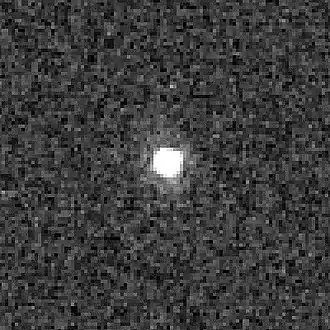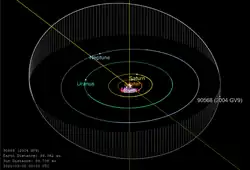(90568) 2004 GV9
 2004 GV9 imaged by the Hubble Space Telescope on 17 March 2010 | |
| Discovery[1] | |
|---|---|
| Discovered by | NEAT (obs. code 644) |
| Discovery site | Palomar Obs. |
| Discovery date | 13 April 2004 |
| Designations | |
| (90568) 2004 GV9 | |
| 2004 GV9 | |
| Orbital characteristics (barycentric)[6] | |
| Epoch 5 May 2025 (JD 2460800.5) | |
| Uncertainty parameter 0[2] or 1[1] | |
| Observation arc | 70+ yr |
| Earliest precovery date | 21 December 1954[1] |
| Aphelion | 45.160 AU |
| Perihelion | 38.730 AU |
| 41.945 AU | |
| Eccentricity | 0.0766 |
| 271.48 yr (99,158 d) | |
| 48.258° | |
| 0° 0m 13.07s / day | |
| Inclination | 21.983° |
| 250.605° | |
| 292.116° | |
| Physical characteristics | |
| 680±34 km[3] | |
| 5.86 h[2] | |
| 0.077+0.0084 −0.0077[3] | |
| 19.9[9] | |
(90568) 2004 GV9 (provisional designation 2004 GV9) is a large trans-Neptunian planetoid that was discovered in 2004 by the Near Earth Asteroid Tracking survey at Palomar Observatory.[10] It is classified as a classical Kuiper belt object of the dynamically "hot" population, which follow highly inclined or eccentric orbits around the Sun.[3]: 2
2004 GV9 is 680±34 km in diameter, according to measurements of its infrared thermal emission by the Herschel and Spitzer space telescopes.[3] It is one of the largest known unnamed objects in the Solar System. Mike Brown estimates that it is likely a dwarf planet.[11] Gonzalo Tancredi notes that light-curve-amplitude analysis shows only small deviations, suggesting that 2004 GV9 could be a spheroid with small albedo spots and therefore could be a dwarf planet.[12] However, its low albedo suggests it has never been resurfaced and thus is unlikely to have the planetary geology expected of a dwarf planet.[13]
Orbit

2004 GV9 is a trans-Neptunian object orbiting the Sun at a semi-major axis or average distance of 41.9 astronomical units (AU).[6][a] It has an orbital eccentricity of 0.08 and an inclination of 22° with respect to the ecliptic.[6] In its 271-year-long orbit, 2004 GV9 comes as close as 38.7 AU from the Sun at perihelion and as far as 45.2 AU from the Sun at aphelion.[6]
2004 GV9 is located in the classical region of the Kuiper belt 39–48 AU from the Sun,[4]: 53 and is thus classified as a classical Kuiper belt object (sometimes known as a "cubewano").[4]: 55 The high orbital inclination of 2004 GV9 makes it a dynamically "hot" member of the classical Kuiper belt.[3]: 3 The hot classical Kuiper belt objects are believed to have been scattered by Neptune's gravitational influence during the Solar System's early history.[15]: 230
See also
- List of possible dwarf planets
- 145452 Ritona – a classical Kuiper belt object and possible dwarf planet similar to 2004 GV9 in size
- List of Solar System objects by size
Notes
- ^ These orbital elements are expressed in terms of the Solar System Barycenter (SSB) as the frame of reference.[6] Due to planetary perturbations, the Sun revolves around the SSB at non-negligible distances, so heliocentric-frame orbital elements and distances can vary in short timescales as shown in JPL-Horizons.[14]
References
- ^ a b c d "(90568) = 2004 GV9". Minor Planet Center. Retrieved 18 August 2025.
- ^ a b c d "JPL Small-Body Database Lookup: 90568 (2004 GV9)" (2025-06-22 last obs.). Jet Propulsion Laboratory. Retrieved 18 August 2025.
- ^ a b c d e f g h Vilenius, E.; Kiss, C.; Mommert, M.; Müller, T.; Santos-Sanz, P.; Pal, A.; et al. (May 2012). ""TNOs are Cool": A survey of the trans-Neptunian region VI. Herschel/PACS observations and thermal modeling of 19 classical Kuiper belt objects". Astronomy & Astrophysics. 541: 17. arXiv:1204.0697. Bibcode:2012A&A...541A..94V. doi:10.1051/0004-6361/201118743. S2CID 54222700. A94.
- ^ a b c Gladman, Brett; Marsden, Brian G.; VanLaerhoven, Christa (2008). "Nomenclature in the Outer Solar System" (PDF). The Solar System Beyond Neptune. University of Arizona Press. pp. 43–57. arXiv:astro-ph/0702538. Bibcode:2008ssbn.book...43G. ISBN 9780816527557. S2CID 14469199. Archived from the original (PDF) on 1 August 2023.
- ^ Marc W. Buie. "Orbit Fit and Astrometric record for 90568" (2004-06-09 using 46 of 47 observations). SwRI (Space Science Department). Retrieved 4 October 2009.
- ^ a b c d e "JPL Horizons On-Line Ephemeris for 90568 (2004 GV9) at epoch JD 2460800.5". JPL Horizons On-Line Ephemeris System. Jet Propulsion Laboratory. Retrieved 18 August 2025. Solution using the Solar System Barycenter. Ephemeris Type: Elements and Center: @0)
- ^ Tegler, Stephen C. (1 February 2007). "Kuiper Belt Object Magnitudes and Surface Colors". Archived from the original on 1 September 2006. Retrieved 30 December 2009.
- ^ David L. Rabinowitz; Bradley E. Schaefer; Martha W. Schaefer; Suzanne W. Tourtellotte (2008). "The Youthful Appearance of the 2003 EL61 Collisional Family". The Astronomical Journal. 136 (4): 1502–1509. arXiv:0804.2864. Bibcode:2008AJ....136.1502R. doi:10.1088/0004-6256/136/4/1502. S2CID 117167835.
- ^ "AstDys (90568) 2004GV9 Ephemerides". Department of Mathematics, University of Pisa, Italy. Retrieved 6 October 2009.
- ^ Spahr, Timothy B. (14 April 2004). "MPEC 2004-G32 : 2004 GV9". IAU Minor Planet Center. Harvard-Smithsonian Center for Astrophysics. Retrieved 6 January 2010.
- ^ Michael E. Brown. "How many dwarf planets are there in the outer solar system? (updates daily)". California Institute of Technology. Retrieved 30 August 2016.
- ^ Tancredi, G., & Favre, S. (2008) Which are the dwarfs in the Solar System?. Depto. Astronomía, Fac. Ciencias, Montevideo, Uruguay; Observatorio Astronómico Los Molinos, MEC, Uruguay. Retrieved 10-08-2011
- ^ Grundy, W. M.; Noll, K. S.; Buie, M. W.; Benecchi, S. D.; Ragozzine, D.; Roe, H. G. (December 2019). "The Mutual Orbit, Mass, and Density of Transneptunian Binary Gǃkúnǁʼhòmdímà ((229762) 2007 UK126)" (PDF). Icarus. 334: 30–38. Bibcode:2019Icar..334...30G. doi:10.1016/j.icarus.2018.12.037. S2CID 126574999.
- ^ "JPL Horizons On-Line Ephemeris for 90568 (2004 GV9) at epochs JD 2460800.5–2461000.5". JPL Horizons On-Line Ephemeris System. Jet Propulsion Laboratory. Retrieved 18 August 2025. Solution using the Sun. Ephemeris Type: Elements and Center: @sun)
- ^ Lykawka, Patryk Sofia; Tadashi, Mukai (July 2007). "Dynamical classification of trans-neptunian objects: Probing their origin, evolution, and interrelation". Icarus. 189 (1): 213–232. Bibcode:2007Icar..189..213L. doi:10.1016/j.icarus.2007.01.001. S2CID 122671996.
External links
- (90568) 2004 GV9 at AstDyS-2, Asteroids—Dynamic Site
- (90568) 2004 GV9 at the JPL Small-Body Database
_(cropped).jpg)
